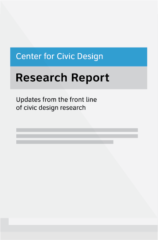Usability of county websites
How well do counties answer voters’ questions about upcoming elections? State election websites are one source, but voters vote at the county or town level. In 2013, we looked at county websites to learn about what local election jurisdictions were offering for content, what terminology they used to describe it, and how useful and usable that content was to voters. The data strongly suggest that voters who live in mostly minority counties are less likely to find answers on their local government websites.

Usability of County Election Websites
Download reportKey findings
Overall, our research suggest that mostly-minority counties’ election websites consistently had fewer keywords that would help voters find answers.
- Minority counties had 10% fewer items on county election website home pages on average than white counties did.
- While 88% of the mostly-white counties had something related to registering to vote on the election website home page, this was true for only 76% of mostly-minority counties.
- The key word “absentee” (as in “absentee ballot”) appeared on 55% of mostly-white counties’ websites, and 46% of mostly-minority counties’ sites.
- “Ballot,” an important key word (could be part of “sample ballot,” “absentee ballot,” or “provisional ballot,” etc.) for an elections website in the weeks leading to a major election, appeared on 70% of election websites of mostly-white counties, but only 54% of election websites of mostly-minority counties.
About the research
This research was conducted by CCD co-founders Dana Chisnell and Whitney Quesenbery and with Cyd Harrell, Andrea Fineman and Ethan Newby.
We identified 147 counties for this study. Based on Census Bureau data, we selected counties that had high populations and low populations, were densely populated by area or sparsely populated by area, and were mostly minority or mostly white.
On the county election websites, we cataloged the contents of the home page, identifying what kind of information was available and where on the page it was located. This gave us a picture of how well the home page covered key election topics and suggested how useful it might be for voters looking for help.
Then, we conducted a distributed usability test with 41 voters from across the U.S. using their own county’s website.
Related resources
Visit our page on voter education to find more resources about creating welcoming voter education materials that invite voters to participate in elections.
We compiled a slide deck showing data for where and how often key words appeared on county election websites in November 2012.
Since 2016, the League of Women Voters in Texas has been reviewing the 254 county websites in Texas using a checklist based on this research. View this amazing compilation of data on the LWV of Texas website.

